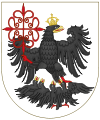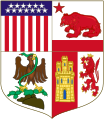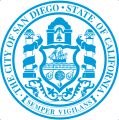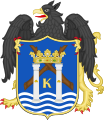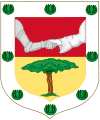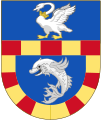Spanish heraldry
This article needs additional citations for verification. (February 2024) |
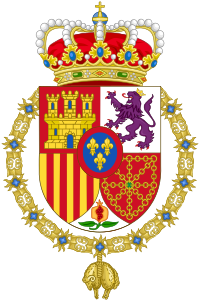
The tradition and art of
Features
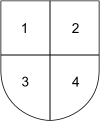
The design of the arms themselves, excepting for the rules of heraldry, were up to the owner, and sometimes the design had a specific meaning or symbolism. Originally, anyone could bear (display) arms. Later, it became more of a practice for the nobility. Until the end of the middle ages only the paternal arms were used but later both the paternal and maternal arms were displayed. The arms of the maternal and paternal grandfathers were impaled (shield cut in half vertically, showing the respective arms on each half). During the 18th and 19th centuries, the use of four quarterings came into use by the nobility (the shield was cut into four parts and the design of the arms of each grandparent was placed in each quarter). The order of display was:
- Paternal grandfather
- Maternal grandfather
- Paternal grandmother
- Maternal grandmother

Origins and history
The Spanish nobility, unlike their other European counterparts, was based almost entirely on military service. Few families of eminence came from the law, commerce or the church. The great families of Spain and Portugal fought their way to their rank, which allowed commoners to join the ranks of the nobility through loyal and successful military service. Many poor families came to prominence and wealth quickly as a result of their successful military exploits. In Spanish heraldry, arms are a symbol of lineage and a symbol of the family as well. Spanish arms are inheritable like any other form of property.
Descent of Spanish arms

The descent of Spanish arms and
- Natural children: Those born of single or widowed parents who could be legitimized by the marriage of their parents or by a declaration by their father that they were his heirs.
- Spurious children: Those whose parents were not in a position to marry. These children had to be legitimized by a petition of royal ratification.
- Incestuous children: Those born of parents too closely related to marry or who were under a religious vow. These hijos required a papal dispensation in order to inherit their parent's arms or property. These papal dispensations were granted so often that every diocese in Spain had signed blanks ready to affix the appropriate name.[citation needed]
Style and practice
Spanish heraldry style and practice follows the Iberian branch of the Latin heraldry tradition, that also includes the
Definitions

The "coat" of arms, or more correctly the achievement, in Spain is composed of the shield, a cape which can be simply drawn or ornate, a helmet (optional) or a
In
-
Sovereign –Royal Crown of Spain
Design of the national arms -
Sovereign – Royal Crown of Spain
Design of the monarch's arms -
Sovereign – Variant for the Spanish Territories of the former Crown of Aragon
-
Crown of the Heir Apparent
-
Heir Apparent – Variant for the Spanish Territories of the former Crown of Aragon
-
Infantes (Princes and Princesses)
-
Infantes – Variant for the Spanish Territories of the former Crown of Aragon
-
Heraldic Coronet of Spanish Grandee
-
Duke
-
Marquess
-
Count
-
Viscount
-
Baron
-
Señor (Lord)
-
Spanish Mural [citation needed] Crown (Generic)
-
Mural Crown of Catalan Provinces [citation needed] (Spain)
-
Mural Crown of Catalan Regions [citation needed]
-
Mural Crown of Catalan Cities [citation needed]
-
Mural Crown of Catalan Towns [citation needed]
-
Mural Crown of Catalan Villages [citation needed]
-
Heraldic Coronet of Spanish Kings of Arms
Military heraldic coronets[1]
Regulation
The Chronicler
The Spanish Cronista de Armas
The post of King of Arms took several forms and eventually settled on a Corps of Chronicler King of Arms (Cuerpo de Cronista Rey de Armas) which was headed by an Elder or Dean (Decano). It usually consisted of four officers and two assistants or undersecretaries which usually acted as witnesses to documents. The entire corps wore a distinctive uniform. The corps were considered part of the royal household and was generally responsible to the Master of the King's stable (an important position in the Middle Ages).
Appointments to the Corps of King of Arms were made by the King or reigning Queen. These appointments were for life and while not intended to be hereditary, often went from father to son or other close family member. The Spanish heralds had other duties which pertained to matters of protocol and often acted as royal messengers and emissaries. They could, and can, make arrangements for areas currently or previously under the rule of the Spanish crown [4]
The precise functions and duties of the
National and civic arms

Like most European countries, Spain has a
Coats of arms are regularly depicted on various buildings and objects belonging to national or local government; in Madrid, even such unglamorous objects as manhole covers are decorated with the civic coat of arms.
Personal arms
Some ancient Spanish families bear personal arms. The
Heraldic regulation
Spain originally had a corporation of
As in other European nations, arms are regulated, and it is unlawful to assume arms belonging to someone else.
Spanish coats of arms are divided in the same fashion used by other European countries. Since coats of arms were granted to new separate families, there was the need to join multiple coats of arms into one when a new branch of a family was formed. Thus Spanish escutcheons are commonly parted.
The tradition of differentiating between the coat of arms proper and a lozenge granted to women did not develop in Spain. Both men and women inherited a coat of arms from their fathers (or a member of a clan who had adopted them). In the case of women they could also adopt the arms of their husbands.
Tinctures
| Tincture | Heraldic name | Spanish name |
|---|---|---|
| Metals | ||
| Gold/Yellow | Or | Oro |
| Silver/White | Argent | Argén or Plata |
| Colours | ||
| Blue | Azure | Azur or Azul |
| Red | Gules | Gules or Rojo |
| Purple | Purpure | Púrpura |
| Black | Sable | Sable or Negro |
| Green | Vert | Sinople or Verde |
Examples of Spanish heraldry overseas
Current
-
Municipal Seal ofBacolor, Pampanga)
(Philippines -
Coat of Arms ofBogota)
(Colombia -
Coat of Arms of Durango
(Mexico) -
Coat of Arms ofGuadalajara
(Mexico) -
Coat of arms of Lima
(Peru) -
)
-
Coat of Arms ofPuebla City
(Mexico) -
Coat of Arms of
Puerto Rico -
Coat of Armsof
Puerto Rico
(Aragonese Arms Variant) -
Great Seal of
Puerto Rico -
Coat of Arms ofS. Antonio
(United States) -
Coat of arms of San Germán
(Puerto Rico) -
Seal of San Diego
(United States) -
Coat of Arms of Santiago
(Chile)
Historical
Spanish Empire
-
Coat of Arms of Bogota
-
Coat of Arms of
the Californias -
Coat of Arms of
Cartagena of the Indies -
Coat of Arms of the Spanish Colony of Cuba
-
Coat of Arms of Cusco
-
Coat of Arms of Guatemala City and Antigua
-
Coat of Arms of Havana
-
Coat of Arms of Manila
-
Old Coat of Arms of Medellín
-
Modern Coat of Arms of Medellín
-
Coat of arms of Mexico City
-
Coat of Arms of
Nueva Galicia -
Coat of Arms of San Juan City
-
Coat of Arms ofYucatan
Overseas Provinces
-
Coat of Arms of
Spanish Guinea
See also
- Armorial of Spain
- Armorial of Spanish monarchs in Italy
- Armorial of the Spanish Armed Forces
- Flag of Spain
- List of Spanish flags
- Symbols of Francoism
References
- ^ Coronets used by Spanish general or senior officers without royal or noble titles.
- ^ ISBN 978-84-9781-559-8. P. 96
- ^ "Untitled Normal Page".
- ^ Official Heraldic Authorities Archived 25 July 2011 at the Wayback Machine at The International Association of Amateur Heralds.
- ^ Francisco Franco, Decreto del 13 de abril de 1951.
- ^ Cronista Rey de Armas of Castilla and Leon.
- ^ Decreto 105/1991, 9 May (Boletín Oficial de Castilla y León de 16 May 1991)
- ISBN 0-7548-1062-3
- ISBN 0-7548-1062-3
- ISBN 0-7548-1062-3
- Spanish Heraldry. A work by Al Sosa Archived 3 September 2011 at the Wayback Machine













![Spanish Mural [citation needed] Crown (Generic)](http://upload.wikimedia.org/wikipedia/commons/thumb/b/be/Spanish_Mural_Crown_%28Common%29.svg/120px-Spanish_Mural_Crown_%28Common%29.svg.png)
![Mural Crown of Catalan Provinces [citation needed] (Spain)](http://upload.wikimedia.org/wikipedia/commons/thumb/7/7d/Corona_mural_diputaci%C3%B3n_o_veger%C3%ADa.svg/120px-Corona_mural_diputaci%C3%B3n_o_veger%C3%ADa.svg.png)
![Mural Crown of Catalan Regions [citation needed]](http://upload.wikimedia.org/wikipedia/commons/thumb/7/7f/Mural_Crown_of_Catalan_Regions.svg/120px-Mural_Crown_of_Catalan_Regions.svg.png)
![Mural Crown of Catalan Cities [citation needed]](http://upload.wikimedia.org/wikipedia/commons/thumb/2/24/Mural_Crown_of_Catalan_Cities.svg/120px-Mural_Crown_of_Catalan_Cities.svg.png)
![Mural Crown of Catalan Towns [citation needed]](http://upload.wikimedia.org/wikipedia/commons/thumb/b/b6/Mural_Crown_of_Catalan_Towns.svg/120px-Mural_Crown_of_Catalan_Towns.svg.png)
![Mural Crown of Catalan Villages [citation needed]](http://upload.wikimedia.org/wikipedia/commons/thumb/c/c4/Mural_Crown_of_Catalan_Villages.svg/120px-Mural_Crown_of_Catalan_Villages.svg.png)

![Captain General[2]](http://upload.wikimedia.org/wikipedia/commons/thumb/9/9b/Heraldic_Coronet_of_Spanish_Captain_General.svg/120px-Heraldic_Coronet_of_Spanish_Captain_General.svg.png)

![Lieteurant General Admiral[2]](http://upload.wikimedia.org/wikipedia/commons/thumb/c/cc/Heraldic_Coronet_of_Spanish_OF-8.svg/120px-Heraldic_Coronet_of_Spanish_OF-8.svg.png)
![Divisional General Vice Admiral[2]](http://upload.wikimedia.org/wikipedia/commons/thumb/3/3d/Heraldic_Coronet_of_Spanish_OF-7.svg/120px-Heraldic_Coronet_of_Spanish_OF-7.svg.png)
![Brigadier General Counter Admiral[2]](http://upload.wikimedia.org/wikipedia/commons/thumb/0/0f/Heraldic_Coronet_of_Spanish_OF-6.svg/120px-Heraldic_Coronet_of_Spanish_OF-6.svg.png)








